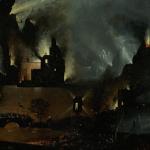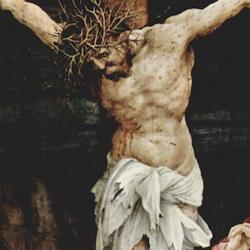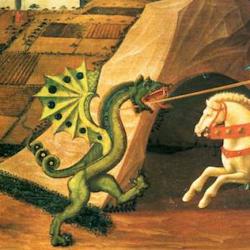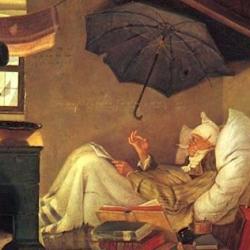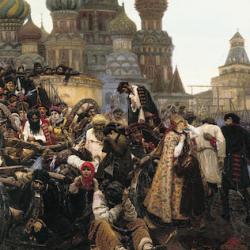On a misty morning in 1703, Peter stood with advisors and surveyed the network of islands that made up the only land mass around the area. As Orlando Figes describes the scene in his magnificent Natasha’s Dance, “With his bayonet he cut two strips of peat and arranged them in a cross on the marshy ground. The Peter said: ‘Here shall be a town.’”
Within four months, they had built the Peter and Paul Fortress on the northernmost island, “the only place to lay firm foundations.” Twenty thousand men were conscripted to work, and half of them died during the project. Stone had to be moved in to raise up the other islands, and it came from Finland, Italy, Poland, and the Low Countries. Only limestone could be quarried locally. In the popular mind, the project was impossible, a miracle, and Peter’s “Here shall be a town” seemed like a new fiat lux.
Petersburg itself was his greatest achievement, both engineering and aesthetic. It seemed an unreal city, built on water. It was as if it had dropped out of heaven – which was in fact one of the myths that surrounded its founding. It was unreal in another way too. The city was to be an Enlightened city, planned from the beginning and employing not only the best engineering but the best possible artistic features.
Unlike other cities in Russia, and most cities in the West, it did not develop over centuries, with different styles and eras jostling together in a confusing whole. It was completed in essentials within only fifty years. It was to be everything that Moscow was not. Moscow was a medieval city, backward, religious, lacking all arts beside the arts of the icon. Petersburg was going to be different. It was, as Dostoevsky says in Notes from Underground, “the most abstract and intentional city in the whole round world.”
Visitors to Petersburg felt the same. Alexandre Benois – editor, painter, art historian, and stage designer for the Mariinsky Theater – wrote after a visit that the city was like a “sergeant with a stick” and had a “machine-like character.” He found in Petersburg “that same Roman spirit, a hard and absolute spirit of order, a spirit of formally perfect life.” Alexander Herzen, who had emigrated from Russia to Western Europe, said it seemed like a military barracks.
Peter’s great Western city opened a window to the West, and the West climbed on through. Russia had been ambivalent about Western influence for a long time, but Peter and Petersburg sharpened the question. No one expressed the ambivalence more powerfully than Alexander Pushkin, in one of his greatest poems, “The Bronze Horseman.”
The poem takes its title from the great bronze equestrian statue of Peter in Senate Square in St Petersburg. The monument itself is a testimony to Peter’s technical achievements. It sits atop an enormous granite rock, 12 meters high and 30 meters in circumference. Figes notes, “Weighing in at some 660,000 kilograms, it took a thousand men over eighteen months to move it, first by a series of pulleys and then on a specially constructed barge, the thirteen kilometers from the first clearing where it had been found to the capital.”
The very form of the statue raises questions. The horse seems ready to plunge over a precipice, and it’s not entirely clear that Peter has control” “Was he about to fall or soar up into space? Was he urging his mount on or trying to restrain it in the face of some catastrophe? . . . The huge granite rock – so wild in its appearance – on which the statue stood, was itself an emblem of the tragic struggle between man and nature” (Figes).
Pushkin’s poem begins as another panegyric to Peter’s achievement, but the story it contains subverts the celebratory tone of the opening lines. The poem is about the flood of Petersburg in 1824. Eugene, the principal character, discovers that the house of his beloved has been washed away in the flood. Despairing, he wanders the streets and comes upon the statue, which he curses. In a scene that could have come from Edgar Allen Poe, the statue comes to life and chases him through the night:
For now he seemed to see
The awful Emperor, quietly,
With momentary anger burning,
His visage to Yevgeny turning!
And rushing through the empty square,
He hears behind him as it were
Thunders that rattle in a chorus,
A gallop ponderous, sonorous,
That shakes the pavement. At full height,
Illumined by the pale moonlight,
With arm outflung, behind him riding
See, the bronze horseman comes, bestriding
The charger, clanging in his flight.
All night the madman flees; no matter
Where he may wander at his will,
Hard on his track with heavy clatter
There the bronze horseman gallops still.
In the morning, Eugene’s body washes up on the same island were his beloved’s house had been before the flood. No wonder Pushkin’s poem became a touchstone of Russian national consciousness.
Come to think of it, the poem resonates much more widely. Pushkin gives us a Weberian nightmare, a chilling portrait of human power turned against human beings. An awesome feat of engineering and artistic skill, the horseman also represents a superhuman power that threatens and crushes the most vulnerable. It is a parable not only of Petersburg, not only of Russia, but of the ultimately futile hubris of modern man.

